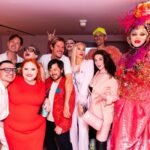Installation view of “The Ancestors Are Talking” at The Whyte Museum of the Canadian Rockies in Banff, Alberta.
The Whyte Museum of the Canadian Rockies in Banff, Alberta.
Joseph M. Sánchez (b. 1948) found his way to western Canada in 1970. He’d spent the past 32 months in the Marine Corps, but wanted nothing more to do with it. With training soldiers bound Vietnam. He left. Without permission.
Growing up on the White Mountain Apache Reservation in Arizona, joining the military seemed like a good idea at the time, as it does for many Native Americans. Native people serve in the U.S. military at five times the national average; higher than any other demographic group.
He’d tried the seminary after high school. College art classes didn’t work out, and when his mother died unexpectedly, there were the Marines.
But he always considered himself an artist. Through it all, he kept making art. Drawing mostly.
From northern British Columbia, Sánchez wound up in Winnipeg. His first wife’s father told him to go see Daphne Odjig (1919–2016; Potawatomi) who operated a small gallery there. Odjig bought the first artwork Sánchez showed her.
That was the start of a long professional relationship, a long personal friendship, and the inception of what would become the Professional Native Indian Artists Inc. (PNIAI), colloquially known as the Indigenous Group of Seven. An exhibition on view now through October 19, 2025, at The Whyte Museum of the Canadian Rockies in Banff, Alberta co-curated by Sánchez, the Group’s last living member, features 77 works from all members including paintings, watercolors, drawings, and works on paper.
Indigenous Group of Seven artists broke barriers, resisting systemic exclusion and redefining Indigenous art within Canada and beyond.
“It was dismal,” Sánchez told Forbes.com about the prospects for Indigenous contemporary artists in Canada in the early 70s. “You were considered a craftsperson, not really an artist, not worthy of being in a museum, looked down upon as being unskilled… there was no place for us.”
Historic and contemporary Indigenous art in Canada, in the United States, around the world, has traditionally been marginalized as “craft” or “ethnographic” by (white) Western scholars. Something other than fine art. Not equal to artists working in a lineage descended from the Greeks and Romans. Indigenous art has been segregated into natural history museums, not art museums.
That has thankfully changed, but those changes occurred decades after the Indigenous Group of Seven officially incorporated in 1974.
In addition to Sánchez and Odjig, the Group’s other members were Jackson Beardy (1944–1984; Oji-Cree), Eddy Cobiness (1933–1996; Anishinaabe), Alex Janvier (1935–2024; Denesuline), Norval Morrisseau (1932–2007; Anishinaabe), and Carl Ray (1943–1978; Cree). Morrisseau is best known, in no small measure because his artwork lies at the center of the largest art forgery scheme in history, a vast, brazen, complex scam dating back to 1995 that continues to be unraveled.
As a group, it was their color palette that is best known.
“(Norval) was an Eckankar follower, so he went off to the astral planes, to the House of Invention, to ask Creator for new colors, to heal the new diseases,” Sánchez explains. “Daphne talked about looking past the veil into other dimensions. Eddie traveled in his dreams. I myself think I astral travel all the time. We were a spiritual group. I think an important part of this is that we reintroduced spirituality to the canon of Canadian art.”
Spirituality represents a key difference between the Indigenous Group of Seven and Canada’s better known early 20th century Group of Seven artists. The number is a coincidence, not a response. The Professional Native Indian Artists Inc. opened membership to anyone interested in joining; only seven were. A Winnipeg newspaper reporter coined the “Indigenous Group of Seven” name.
“If you compare the traditional Group of Seven with the Indian Group of Seven, traditional has no people; the landscape is very spiritual, I’ll grant that, but if you take the Indian Group of Seven, it’s all about everything that lives on this planet, every little creature, that we’re all connected. The story is more about oneness and not about an individual power,” Sánchez said.
An exhibition for the traditional Group of Seven at The Whyte in summer of 2024 encouraged the museum’s Curator of Indigenous Initiatives, Dawn Saunders Dahl (Métis), to approach leadership about following it up with a show for the Indigenous Group of Seven this year.
‘The Ancestors Are Talking’
Norval Morrisseau, ‘Woman and Child Looking at the Mountains,’ 1985, acrylic on canvas, 122 cm x 91 cm.
Photo copyright EA Studios (Jasper), Ltd, 2025.
“The Ancestors Are Talking” highlights the artistic progression of each member, exploring key developments in their careers, from early sketches to masterworks and public art commissions. Artworks are inspired by the mountains of Jasper, the Boreal Forest, and images of strength, family, resistance, nature, and ceremony.
Art, color, culture, and spirituality filled the group’s early conversations.
“Everybody would stop by to get a cup of coffee (at Odjig’s gallery) and it also had this warehouse in the back that became the Warehouse Gallery,” Sánchez remembers. “That became a place where we could really spend time sitting around talking, talking about art, looking at our stuff because everybody that came through always brought something in. It was always a show and tell of some sort because Daphne always had new work. You always had to have something going on.”
Winnipeg was fertile ground for Indigenous artists. In addition to Odjig’s gallery, Beardy and Cobiness lived in the area along with Sánchez.
Excluded from the broader “mainstream” community of (white) galleries, museums, curators, and collectors, they formed their own.
“The market required (Indigenous artists) to make Indian art, make stuff with Indian stuff in it. That was the demand from the buying public, the government, Indian Affairs, they wanted even to put a stamp on our work that said, ‘Official, authentic Indian art, authorized by the Government of Canada.’ We said, ‘no way,’” Sánchez explained. “Everything was qualified as ‘Indian.’ You’re not an artist. You’re an ‘Indian’ artist. That was something Daphne carried throughout her life, saying she’s an artist, the fact that she’s Indian is just a bonus.”
This made the artists activists in a very real way, resisting racist, colonial categorization. Getting out of bed each morning as an Indigenous person in North America–artist or not–is an act of defiance in the face of a 500-year effort toward genocide.
The Group formed in an era of activism. Anti-war, Black Power, the Chicano Movement, and, of course, the American Indian Movement. Native American occupation of Wounded Knee and Alcatraz was taking place at this same time.
Maybe not revolutionaries, but Sánchez considers the Group’s art revolutionary.
“The Woodland school had never been established; that sharing of traditional knowledge came out through Norval and Carl Ray and Jackson, but it also came at a time when (we) were experimenting as artists, experimenting in techniques,” Sánchez said. “Daphne taught herself how to paint like the French Impressionists in oil, so she was part of the Royal British Columbia Art Society. The skill level was really high. We experimented in different sizes, forms, collages, and weren’t afraid to take chances.”
The Indigenous Group Of Seven
The Whyte is a cultural hub in the heart of the Canadian Rockies committed to preserving the region’s art and heritage. Established in 1968 by local artists and philanthropists Peter Whyte and Catharine Robb Whyte, the Museum holds the largest art collection dedicated to the region, encompassing over 10,000 pieces from the early 1800s to the present day. The couple deeply valued their relationships with area’s Indigenous communities, recognizing the importance of preserving and sharing their cultural knowledge and heritage.
“The Ancestors Are Talking” is one of many reconciliation efforts developed and implemented by the museum. The exhibition also lays the groundwork for an Indigenous Mentorship Program, led by Sánchez and Dahl. Seventeen local Indigenous artists have been invited to create new works inspired by “The Ancestors Are Talking.” In this program, artists will have an opportunity to work directly with Sánchez, further developing their practices. The artists will be encouraged to research historic works and material culture in The Whyte’s collection.
This program honors the original intention of the Indigenous Group of Seven, to amplify the voices of Indigenous artists, as well as its desire to help young artists reach their potential. Artworks created through this program will be exhibited at The Whyte in 2026.
“The Ancestors are Talking” marks the first time artworks from all members throughout their entire careers–starting with a 1967 Jackson Beardy through a 2025 Joseph M. Sánchez–are on view in one exhibition together. The Professional Native Indian Artists Inc. never officially disbanded. Their incorporation papers were not renewed in 1979 as members began going their separate ways.
After having been wanted by the FBI for desertion, Sánchez took advantage of President Gerald Ford’s amnesty program for Vietnam War “deserters” and was repatriated in 1975. He’d return to his farm in Manitoba until selling it in ’79-80. He’d return later to see Odjig periodically. He kept in touch with the other members to one degree or another, as they all did. Carl Ray died in his mid-30s. Morrisseau, Odjig, and Janvier all would receive solo shows at Canada’s National Gallery.
As PNAI’s archivist, Sánchez has taken on the responsibility of assuring its legacy. In addition to this exhibition, he’s working with the Museum of Aboriginal People’s Art and Artifacts at Portage College in Lac La Biche, Alberta as Chief Curator, starting the museum’s collection of Indigenous Group of Seven artworks from his personal holdings in 2008. It’s the only permanent display of PNAI art in Canada.



No Comment! Be the first one.